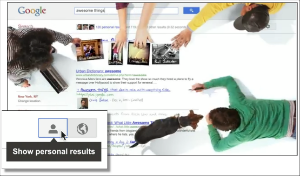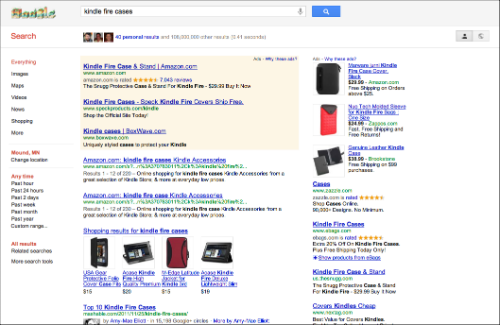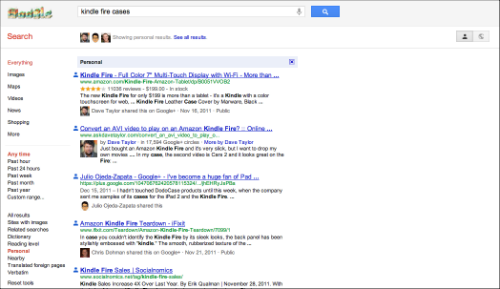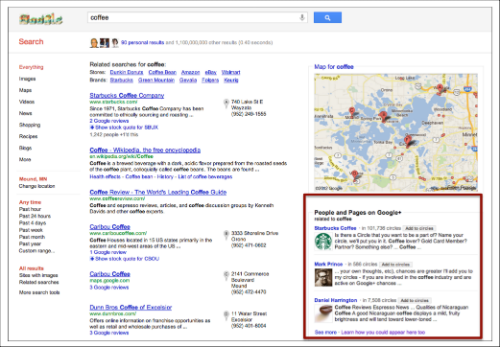
Screenshot from Google's promo video
Google Personalized Search rolled out yesterday revealing a change as significant as Universal Search in 2007. Unlike the major change that brought images, video thumbnails, news and blog posts within search results for all, the Google plus Your World changes are only visibile when logged into Google.
There are many stories to be told here, from Google as a social network to the tit for tat statements Google and Twitter are making. From an online marketing perspective and more specifically, search marketing, the introduction of more Google features only available when logged in will arguably increase the number of searches done when user search terms are encrypted and not available for website owners in their web analytics. The “Unknown” category of keyword referrer for this blog has risen dramatically, which isn’t helpful for future content refinement or optimization.
That aside, here are some observations for you as a marketer as it relates to Google Personalized Search and more specifically, the recommended personal and brand pages.
Many of the initial observations about the Google+ integration with Google search are that Google is favoring it’s own content over others. Facebook and Twitter, two of the most popular social networks on the internet are absent. Google states that if those services will share their data, Google would look at including it. From what I’ve read, Twitter decided not to renew their agreement with Google and Facebook isn’t exactly a “fan” of Google’s.
Matt Cutts from Google posted a response to the initial statements about Google nepotism in the new social Google and to clarify that other sources can appear in personalized results, like Quora or Flickr. What he doesn’t clarify is a preference for Google content. There’s a big difference between the possibility of varied sources appearing and a bias towards certain sources causing them to appear the majority of the time.
The default search option shows a blend of standard web content plus personalized results from the Google+ network connected to the account you’re logged in under. When I did a sample search for “kindle fire cases”, the search results were pretty good. My intent for the query was to find a case to buy for my daughter so the flavor of SERPs towards products for sale was very relevant.

Regular Google SERPs for "Kindle Fire Cases"
However, when I selected the Personalized Results option at the top of the page, the information was hardly useful and not even relevant to the query. A big reason for that is the data set Google is drawing from: my Google+ social network associated with my Google Apps email account. Don’t get me started on the extremely disappointing snails pace Google has taken at providing a Gmail G+ to Google Apps G+ migration tool. But the relevance here is that over 10,000 people have added me to their circles on my Gmail G+ account. All that content and interaction would provide a richer set of search results, except Google isn’t showing me the Search plus Your World interface when I’m logged in using that much larger network account. Instead, I have to use a Google Apps G+ account with virtually no network and very little content and interaction.

Google Personalized Search Results for "Kindle Fire Cases"
Like all social network focused services, the network effect is critical for the service to be really useful. The more people that sign up for and use Google+, the more rich signal Google will have to provide a better search experience based on that network. It’s a wisdom of the crowds as applied to search, so to speak.
While the blend of general results with personalized results is interesting, I’m cautious about how useful it will be. Search and social networking are two very different consumer behaviors. Search tends to be more linear, specific and goal focused. Social networking is often a bit fuzzier and random. You can certainly find answers in either channel, but getting to those answers is a bit different. So, does that mean the convergence of search and social network is the answer?
For me, it’s really hard to tell at the moment because Google isn’t showing me the Search plus Your World option with my larger Google+ network. But I’m sure it will be enabled eventually. Hopefully a LOT faster than the Google Apps migration tool for Google+ accounts.
One of the interesting features of the new Google search results appears with very broad queries called Related People and Pages. When I started testing this last night, related people and pages appeared for a variety of terms ranging from art to marketing. Today, they are only appearing for certain terms like coffee. You can see below that the search results for the coffee query are quite useful and show in the bottom right corner, the related pages and people. From a search perspective, I’m not sure how many people type in “coffee” vs. a specific coffee shop or brand of coffee. The genric term would bring back such a large number of search results they wouldn’t be useful. However, in this case they are.

When you hover over the identities in the People and Pages on Google+ area, you can add them to your own Google+ Circles. This is a handy feature and for marketers, it should be something worth considering in terms of optimizing Google+ content and social behaviors in order to attain visibility as a recommended Person or Page in conjunction with relevant keyword queries. Google offers some advice on this and I think the tips that are shared speak to overall Google+ and new Google.com optimization opportunities, not just optimizing to become a recommended Page.
One of the key Google+ takeaways for marketers is that the more people who have added your personal or business Google+ page to their circles, the greater the likelihood that your content or activity will appear in their search results. In the way that bots crawling and indexing web pages was the price of admission into the Google index, now it’s sharing and interaction amongst your Google+ network that is necessary (along with relevant content – same as it is with web pages).
Below I’ve listed the 3 tips shared by Google and have added my own commentary and interpretation as advice for online marketers that want to better understand how to optimize content and social behaviors for more prominent visibility on Google+ and Google.com search.
1. Make it easier for people to find your brand by creating your +Page. Make sure to add a high quality photo and fill out the “About” section so people can recognize your +Page.
[Brands need a +Page to be found in Google. A photo and About sections are probably priority content areas (for G+ optimization]
2. Share and comment on the topics you care about and Google will share your posts and comments with your Google+ followers when they’re searching.
[For keywords and topics you’d like to be known for and found with, create and share content as well as make comments along those themes on G+. Those actions can surface your content and activity within the search results of those who have added you to their circles. The more people in your circles, the more who will be exposed to your content and social actions.
3. Once you’ve created a +Page and engaged with your audience on topics you’re interested in, you’ll be eligible to appear on the right hand side of search results. The more quality content you create and the more people that engage with your page, the more prominent your +Page will become.
[Social interaction and I’d assume some level of network size/quality of interaction can trigger the appearance of your People or Brand page as a related item on the right of Google Personalized Search results. The ranking of your personal or brand page depends on a quantity of content in combination with the quantity and quality of responses to that content]
In the end, many of the same rules for successful networking with Facebook, Twitter or any other social network apply to Google+. The question is, how will consumers respond? Do you know enough about your consumers to be able to adjust your content and social engagement approach? Or even your approach to SEO? It’s go time, it’s adapt or die time.


